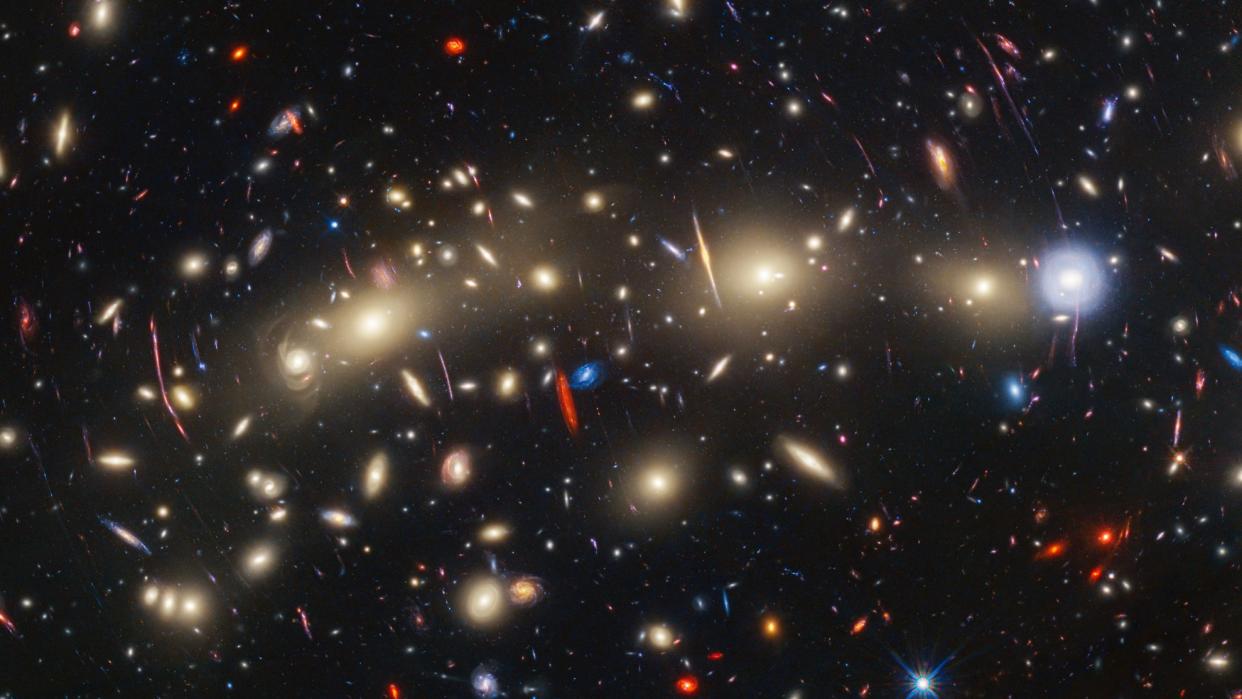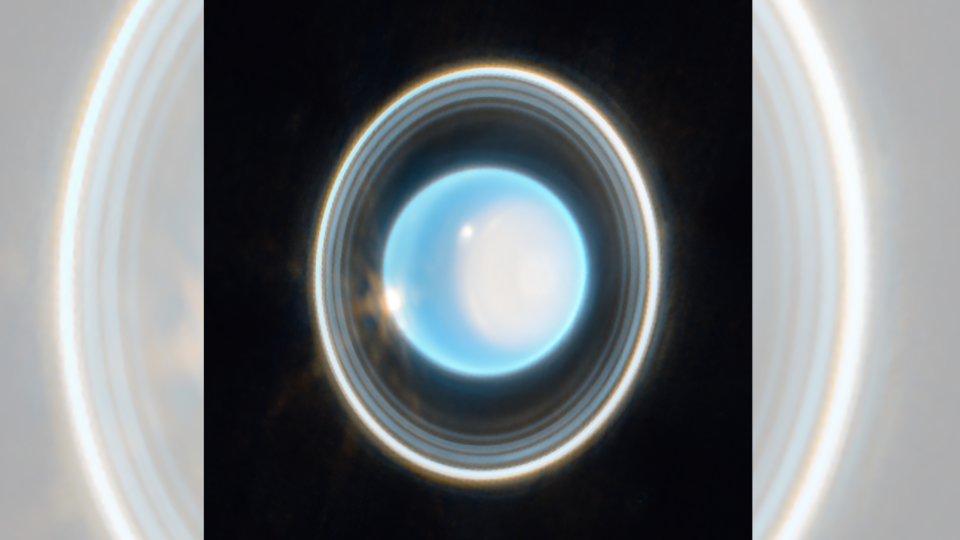8 of the most gorgeous space images of 2023

From cosmic carnival parades in the most colorful image of the universe ever taken to the acrid surface of a supervolcanic moon — space really went out of its way to be beautiful in 2023. Here are our 8 favorite space photos of the year.
The Euclid space telescope's first images

The European Space Agency's Euclid telescope launched into orbit aboard a SpaceX Falcon 9 rocket this year. The telescope is designed to map the composition of the "dark universe" — the collective name given to dark matter and dark energy — but it's also great at capturing wide-angle images of the cosmos.
And the first images captured by the space telescope are no exception: they're absolute jaw-droppers. Wispy gas clouds, clusters of glowing stars and swirling spiral galaxies abound.
Perhaps our favorite is the image of the Horsehead Nebula. A stellar nursery located 1,500 light-years away in the Orion Nebula, this closest star-forming region to Earth is packed with stars shimmering beneath a rolling fog of gas and dust.
Besides mapping the invisible dark matter and energy in this region, Euclid will also search for Jupiter-mass planets, brown dwarfs and infant stars.
Juno looks at Io

This stunning image of Jupiter's third moon Io, snapped by NASA's Juno spacecraft, is the highest-resolution image taken in the last 22 years.
Io is the most volcanic world in our solar system and 100 times more volcanic than Earth. And it shows. Volcanoes on its surface belch wisps of gas across the moon's pockmarked face. Look to the top of the image and you'll glimpse never-before-seen details of the moon's northern polar region, which is crowned by a group of mountains as tall as 20,000 feet (6,000 meters).
JWST ring nebula

Appearing to resemble either an all-seeing cosmic eye or the unfortunate remains of an oversized jelly doughnut dropped from a great height, this James Webb Space Telescope (JWST) image of the 2,000 light-year distant Ring Nebula has a lot to take in.
Named for its large central and 10 concentric outer rings, the layers of this squished gas cloud were formed as the final act of a dying star, which shed gas layers that were then pulled into massive smoke rings by a smaller neighbor star.
Compare this image to a 2013 image taken by the Hubble space telescope, and the unprecedented power of the JWST is very easy to appreciate.
James Webb telescope reveals gargantuan 'Mothra' star in most colorful image of the universe ever taken

Taken with the JWST's powerful infrared imaging instruments, this stunning parade of stars and galaxies across the galaxy cluster MACS0416 was spotted 4.3 billion light-years from Earth.
Within the cosmic carnival are pinwheels of galaxies, ribbons of dust, and the warped neon of remote starlight that has been stretched by the space-bending gravity of enormous star clusters.
And images like this aren't just useful for blowing our minds — the panchromatic display is captured in multiple wavelengths of light in one stretch of space. By measuring the shifts in these wavelengths due to the constant expansion of the cosmos, astronomers can determine the distances between the many background and foreground objects.
'Hidden' rings of Uranus revealed in dazzling new James Webb telescope images

The chilly outer planet Uranus, located roughly 1.8 billion miles (2.9 billion kilometers) from the sun, isn't thought of as a "ringed planet", but that's because its rings are far too faint to be seen by most telescopes.
In fact, it took until the 1986 flight of the Voyager 2 spacecraft out beyond the edges of our solar system for astronomers to confirm the existence of Uranus' 13 rings — which are composed of a mix of finely crushed ice and dust.
Eleven of the planet's 13 rings can be seen in this image. The final two are so faint that they can only be viewed when the planet is tilted to face Earth such that all of its rings overlap. That last happened in 2007, when the Hubble Space Telescope snapped the complete set. The next opportunity will be in 2091, once the planet has sufficiently rotated on its side relative to the Earth to give us (or more likely our children and grandchildren) the next peek.
Extremely rare 'rainbow clouds' light up Arctic skies for 3 days in a row

Put aside the multi-million dollar telescopes for a moment, because here's a sight that can be taken in with two eyes and an upturned head — provided, of course, you can brave the below-freezing temperatures of the Arctic.
Captured above Gran in southern Norway by the photographer Ramun? ?apailait?, these beautiful iridescent clouds began shimmering over the Arctic in late December due to a cold snap in the upper atmosphere. They're known as polar stratospheric clouds (PSCs) or nacreous clouds (nicknamed after the iridescent sheen of nacre or mother-of-pearl) and are caused by sunlight scattering through tiny ice crystals suspended in the air.
James Webb space telescope finds a secret at the Crab Nebula's heart

Sitting at the core of the Crab Nebula are the sputtering remnants of an exploded star. It went supernova in A.D. 1054 and the husk of the once massive star at the heart of the nebula is now a neutron star, rapidly spinning out streaks of gas in all directions.
Training the JWST's camera on this nebula revealed wispy gas filaments in orangey red dotted with yellow-white and green dust grains. But it's the azure smokey glow that captivated NASA scientists, as it may be the radiation produced by charged particles zipping along magnetic field lines made by the neutron star — possibly the first image of its kind.
NASA's OSIRIS-REx capsule returns to Earth with a sample from the 'potentially hazardous' asteroid Bennu

It might seem cruel to end a countdown of spectacular fluorescent images with a photo of a black and white space rock. But it's what's on this rock that has us excited: the possible precursors to life on Earth.
RELATED STORIES
—After 2 years in space, the James Webb telescope has broken cosmology. Can it be fixed?
—8 stunning James Webb Space Telescope discoveries made in 2023
— James Webb telescope discovers oldest black hole in the universe
The asteroid is called Bennu, a potentially hazardous asteroid that has a 1-in-2,700 chance of striking Earth in the year 2182 — the highest odds of any known space object. But the main reason that NASA's OSIRIS-REx spacecraft landed on this pile of distant rubble are the chemicals that lurk on the surface.
"This is the biggest carbon-rich asteroid sample ever returned to Earth," NASA Administrator Bill Nelson said at a news conference upon the sample's return to Earth. "Carbon and water molecules are exactly the elements we wanted to find. They're crucial elements in the formation of our own planet, and they're going to help us determine the origins of elements that could have led to life."
Tiny slices of the overall sample have been retrieved and sent to labs around the world. And with some initial results possibly coming as early as 2024, we can't wait to see what's on board.